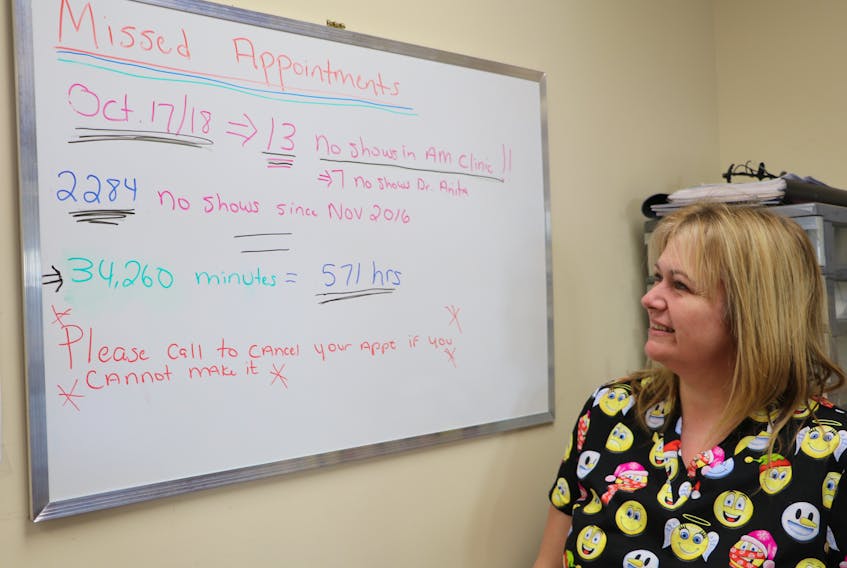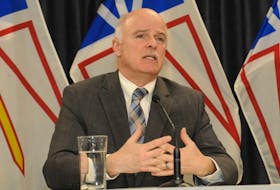The number of missed appointments scribbled on a large whiteboard on the wall behind the reception desk at Eleven Elizabeth Family Practice on Elizabeth Avenue in St. John’s last week is staggering.
Written in blue and pink marker, the number is emphasized by thick black underlines to indicate its seriousness.
The sign is easily visible to patients and visitors to the office. It reads “2,284 no shows since November 2016.” For the Oct. 17 a.m. clinic alone this year there were 13 no shows. No shows are patients who don’t bother to show up or even call to cancel their appointment.
The total wasted time that could have been used to see patients who really need to see their doctor at the clinic adds up to 571 hours since November 2016. The clinic loses money it can’t make up for and the waitlist grows longer because of it.
Dr. Anita Pushpanathan, one of nine fee-for-service family physicians — plus one senior resident — who operate out of Eleven Elizabeth Family Practice, says the issue of “no-shows” negatively affects the entire health-care system in the province.
She said the main concern at their clinic is accessibility to care for patients.
“Our No. 1 concern about this problem, its impact on our practice, is access to care for the other patients. Because out of those 40-50 calls per hour we are having to turn down a lot of patients requests to be seen and those no-show appointments are clogging up the wait time for them.”
Dr. Anita Pushpanathan
“There was a day in October I had seven no-shows on one day. That’s just not good enough,” she said. “I have thousands of patients in my practice, and a lot of young families with sick kids so we would like to try to get those kids in, and elderly patients who are frail, whom we try to prioritize to get them in quickly.
“We hear from Eastern Health, the provincial government, to try to make efficiency and access to care a priority here, and to do that we have to try to tackle this issue of no-shows.”
The issue of no-shows has long been a problem in health care in the province. It’s a major cause of growing wait times throughout the health-care system.
Guidelines for physicians
The Newfoundland and Labrador Medical Association has published guidelines on its website for physicians and specialists to deal with no-shows.
Specialist offices have the discretion to establish a missed appointments policy, part of which may be the refusal to reschedule a new appointment with the patient after appropriate efforts have been made to reschedule the appointment. Specialists should communicate their policy to patients, including the amount of advance notice required to reschedule an appointment and how many missed appointments may occur before the specialist will discharge the patient from the specialist’s care.
There is advice also that physicians set up office systems to help identify patients who engage in non-adherence, such as missed appointments, cancellations, or failure to follow up on referrals, and discuss the reasons for non-adherence with patients to better understand any barriers and then work to overcome the barriers by suggesting alternatives or providing additional information or confirmation.

The NLMA states that it believes that regional health authorities should invest in appointment notification systems (ANS) and other measures to improve adherence to appointments and to remove administrative burden from physician offices.
The website notes that an ANS was introduced in November 2016 in an effort to reduce the number of no-shows to clinical appointments, a concern of all four regional health authorities in the province. With automated notifications, patients are notified by phone, text or email a week prior to an appointment so they may either confirm the appointment, and make required preparations, or cancel the appointment, allowing other patients to be booked in unfilled appointment slots.
Pushpanathan said the Eleven Elizabeth clinic sees about 200 patients per day and over four phone lines there are about 40-50 calls per hour — people wanting to make appointments, inquire about test results, ask health-care related questions, and to request services such as refills.
Patients are being turned away or told they have to wait for days or weeks when they could be availing of the no-show slots.
“Our No. 1 concern about this problem, its impact on our practice, is access to care for the other patients. Because out of those 40-50 calls per hour we are having to turn down a lot of patients requests to be seen and those no-show appointments are clogging up the wait time for them.
“We do have some things in place … our frontline staff are the ones who relay the messages that you did miss your appointment. And occasionally we do have to send a letter in the mail advising people that if you continue to miss appointments then they are not going to be able to book in the future. We are also currently utilizing the TELUS provincial EMR (electronic medical record) MED Access. We are exploring patient reminder opportunities such as text message, email, and those do come at a significant cost — at least $1,000 per year per physician so we need to explore feasibility there.
“One other concern we had about it is that when patients miss appointments then we start getting requests from those patients for prescription refills over the phone. Our concern about that is the sort of risk involved in terms of doing that type of service without seeing the patient. It’s more safety in patient care. Patients need to be monitored, be asked about side-effects for safety for medications.”
No-shows are financial burden
No-shows also hurt the medical office through lost income. The office has a huge overhead including rent, staff salaries and equipment. And patients who do not miss appointments are frustrated about the long wait times they must endure because of the lost time caused by no-shows.
“We are bound by governing laws from the College of Physicians and Surgeons. Their guidelines are posted online with regards to ending a doctor-patient relationship. It states that if someone frequently misses appointments we are allowed to dismiss that patient, however, it doesn’t explicitly state what that number is. So that’s up for interpretation on a case-by-case basis,” Pushpanathan said.
“I think there’s no easy answer on how to solve it. I think it’s a bit on our part to help with reminding as well as it has to be a two-way street, responsibility on the patient’s side as well.”
Dr. Joseph F. Coffey runs a dermatology clinic in St. John’s that averages about 75-80 patients seen per day. The number of no-shows, once again, is staggering.
“The problem is patients need to take more responsibility for their medical care. They don’t realize how it affects the physicians’ office and our waitlists if they don’t attend their appointments.”
Dr. Joseph Coffey
“Our waitlist has skyrocketed because of the number of no-shows, so this year as of Dec. 1, there have been 1,300 no-shows in my office,” he said. “That doesn’t include people who call to reschedule an appointment. These are people who didn’t bother to keep their appointment despite all the efforts we made to bring them here.”
Coffey notes that the time of year and weather conditions don’t make a difference. In February of 2018, for instance, there were 44 no-shows and in August there were 180 no-shows.
“It is very frustrating for us as physicians because it can’t be blamed on flu season or the weather,” he said. “The problem is patients need to take more responsibility for their medical care. They don’t realize how it affects the physicians’ office and our waitlists if they don’t attend their appointments.”
With the wait time increasing due to no-shows, some patients will ask their family doctors to refer them to a second dermatologist and to see if they can get in faster. This, notes Coffey, often results in a no-show for one of the dermatologists because patients don’t bother to cancel the appointment they are not using. Also, he said, referring doctors should not make a second appointment without cancelling the first. There needs to be better communication among health professionals, he said.
Coffey said no-shows cause a significant financial burden, in addition to increasing the wait time about four weeks each year. He said there’s about a 40 per cent overhead to run his office — there’s nurses, receptionists and office manager salaries, regular office bills, and the purchase and maintenance of equipment used to treat patients.
“There’s a major loss of income that we can’t reclaim,” he said.
Coffey said they’ve also tried numerous ways to remind patients of their appointments.
“We make two-day and seven-day reminder calls to our patients, so we have to pay a staff member to just be on a phone calling to try to remind people to make their appointments,” he said. “So, when they are a no-show it is frustrating because we have a lot of patients who are actually verified by phone, or a message has been left with a responsible family member, and they still don’t keep their appointments.
“The nurses I have — I have four nurses — and they are calling anyone who has a message manager five to 10 times the rest of the week to try to reach them and convert them to verified patients who are going to come in. So, we are actually putting a lot of work into trying to make sure people do get here.”
Electronic reminders only partially effective
Coffey said the suggestions of electronic reminders is a good idea, but one that doesn’t work well with older patients who are not up-to-date on modern communications technology.

“Most of our patients are 65 and older and a lot are not comfortable using the internet or text messaging,” he said.
“In the U.S. you don’t see these no-shows because patients are financially responsible to keep those appointments. It may take that here in Canada whereby the government will cover your appointment, but if the patient is a no-show they should be invoiced a fraction, at least, of the cost of that missed appointment.”
According to Eastern Health’s website, the health authority implemented a new policy to address the number of no-shows to its adult ambulatory clinics, as well as diagnostic imaging appointments.
Approximately one million appointments are scheduled annually at Eastern Health’s adult ambulatory clinics, sometimes referred to as the outpatient specialty clinics. They include a variety of program areas, such as endoscopy, orthopedics, diabetes, and physician appointments, among others.
Statistics for fiscal years 2016-2017 indicate that 10.4 per cent of patients either did not show up for their appointments — or did not cancel with sufficient notice. This equates to just over 97,000missed appointments, which have a significant impact on both the organization’s resources and its waitlists.
With the implementation of the policy, the rate of no-shows for the fiscal year 2017-2018 showed some improvement. The number of no-shows amounted to just over 95,000 missed appointments or 10.4 per cent.
When a person doesn’t show at the appointed time, or doesn’t give sufficient notice, diagnostic equipment lies idle, as there is no time to offer that appointment to someone else, resulting in wasted resources of both staff and equipment. Additionally, the no-show patient usually needs to be rebooked, which, in turn, slows down the booking/appointment process overall.









